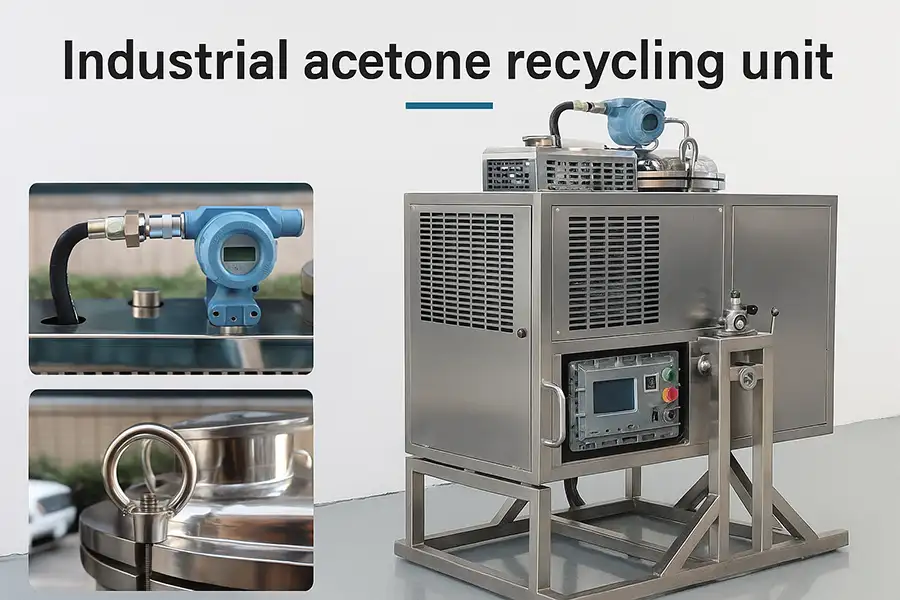Acetone Recycling: How It Works and Why It Matters
Acetone is one of the most commonly used solvents in industries such as pharmaceuticals, automotive, and coatings. While its cleaning and dissolving properties make it incredibly valuable, improper disposal can harm both the environment and human health. That's where acetone recycling comes into play — a process that not only reduces waste but also saves costs and supports sustainability goals.

What Is Acetone Recycling?
Acetone recycling refers to the recovery and purification of used acetone so it can be reused in industrial applications. Instead of discarding contaminated acetone, companies use specialized solvent recycling machines to distill and reclaim the solvent. This process removes impurities and restores acetone to near-original purity levels.
Why Recycle Acetone?
According to a 2022 report by the International Chemical Engineering Association, solvent recycling can reduce solvent purchasing costs by up to 80% annually. Furthermore, recycling minimizes hazardous waste generation, lowering disposal fees and environmental compliance risks.
Yes. When properly distilled using modern solvent recycling systems, recycled acetone can achieve purity levels exceeding 99%. In many industrial cleaning and coating applications, this makes it virtually indistinguishable from virgin acetone.
How Does Acetone Recycling Work?
The recycling process typically involves distillation — heating the contaminated acetone until it vaporizes, then condensing the vapor back into liquid form. Impurities with higher boiling points remain behind, leaving purified acetone ready for reuse.
Modern solvent recyclers, such as those offered by Solvent Recyclers, automate this process with precision temperature control and safety features that prevent overpressure or overheating. Learn more about the solvent recovery process.

Key Components of a Solvent Recycling Machine
Distillation Chamber: Where the solvent is heated and vaporized
Condenser Unit: Converts vapor back to liquid acetone
Collection Tank: Stores the purified solvent
Control Panel: Allows operators to set parameters and monitor performance
Safety Systems: Includes pressure relief valves and automatic shutoff features
Recovery efficiency depends on the contamination level and machine design. High-quality solvent recyclers can reclaim between 85% and 95% of used acetone per cycle. This means less waste and more usable solvent for subsequent applications. For larger operations, consider industrial solvent recovery units.
Operational Efficiency Note
A well-maintained solvent recycling machine can process between 5-50 gallons per cycle, with modern systems offering completely automated operation cycles. The average ROI period for solvent recyclers is less than 18 months.
Environmental and Economic Benefits
Acetone recycling offers dual advantages — environmental protection and financial savings. By reducing the need for fresh solvent purchases, companies lower their operational costs. At the same time, they minimize hazardous waste, aligning with global sustainability standards such as ISO 14001.
According to a study by the European Environmental Bureau, solvent recycling can cut industrial VOC (volatile organic compound) emissions by up to 60%, directly contributing to cleaner air and safer workplaces.
Economic Advantages
Reduce solvent costs by 80% annually | Eliminate hazardous waste disposal fees | Qualify for eco-friendly tax credits and government subsidies
Environmental Benefits
60% reduction in carbon footprint | Drastically reduced hazardous waste | Resource conservation and circular economy compliance
Real-World Applications
Industries that benefit most from acetone recycling include:
Automotive paint and coating facilities
Pharmaceutical laboratories
Electronics manufacturing plants
Composite and resin production
Industrial cleaning services
For comprehensive guidance on managing solvent waste generated by these industries, read our complete solvent waste disposal guide.

Safety and Compliance
Proper handling of acetone recycling systems ensures compliance with environmental regulations. The U.S. Environmental Protection Agency (EPA) emphasizes solvent recovery as a key strategy for reducing hazardous waste under the Resource Conservation and Recovery Act (RCRA). Modern systems incorporate explosion-proof designs and temperature monitoring to maintain safety. Proper solvent waste management is critical for compliance.
Absolutely. Compact solvent recyclers are available for small-scale operations, offering the same efficiency as industrial units but with lower capacity. This allows workshops and labs to reduce waste and costs without investing in large infrastructure.
Choosing the Right Recycling System
When selecting an acetone recycling machine, consider factors such as capacity, energy efficiency, and automation level. Systems like those from Solvent Recyclers are designed for durability, precision, and compliance with international safety standards. Key considerations include:
Maintenance and Longevity
Routine maintenance ensures consistent performance. Cleaning the distillation chamber and checking seals prevent contamination and leakage. With proper care, and following our maintenance guidelines, a solvent recycling machine can operate efficiently for over 10 years.
Maintenance Tips
Monthly deep cleaning of distillation chamber
Quarterly gasket and seal inspections
Annual professional calibration and safety check
Continuous monitoring of recovery efficiency
Conclusion: The Future of Acetone Recycling
As industries worldwide shift toward sustainable practices, acetone recycling stands out as a practical and impactful solution. It reduces environmental impact, cuts costs, and supports cleaner production processes. With advancements in solvent recovery technology, including AI-powered monitoring and automated systems, the future of acetone recycling looks promising — efficient, safe, and essential for a greener planet.
Additional Resources
For more insights on solvent recovery and equipment options, explore these resources:
